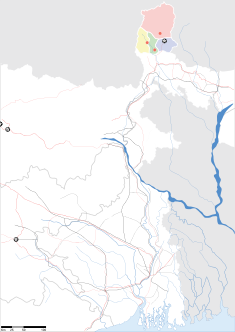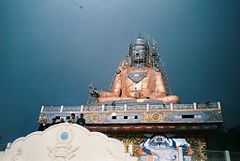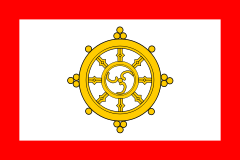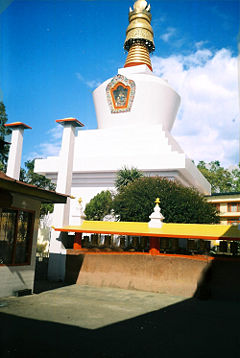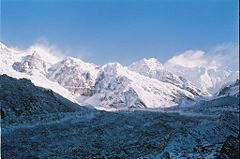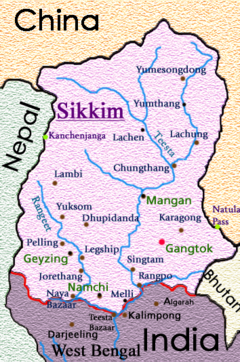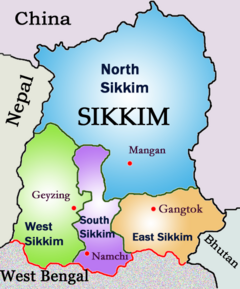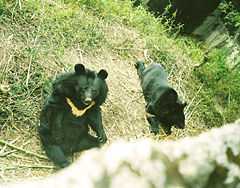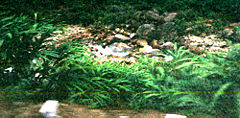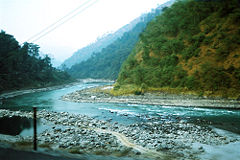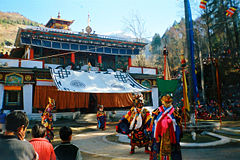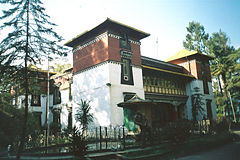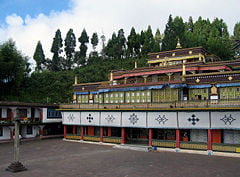Sikkim
| Sikkim India | |
| Coordinates: | |
| Time zone | IST (UTC+5:30) |
| Area | 7,096 km² (2,740 sq mi) |
| Capital | Gangtok |
| Largest city | Gangtok |
| District(s) | 4 |
| Population • Density |
540,493 (28th) • 76.17 /km² (197 /sq mi) |
| Language(s) | Nepali |
| Chief Minister | Pawan Kumar Chamling |
| Governor | Sudarshan Agarwal |
| Established | 16 May 1975 |
| Legislature (seats) | Unicameral (32) |
| ISO abbreviation | IN-SK |
| Website: sikkim.nic.in | |
| Seal of Sikkim | |
Coordinates:
Sikkim (Nepali: सिक्किम ▶, also Sikhim) is a landlocked Indian state nestled in the Himalayas. It is the least populous state in India,[1] and the second-smallest in area after Goa. The thumb-shaped state borders Nepal in the west, Tibet Autonomous Region of China to the north and east, and Bhutan in the southeast. The Indian state of West Bengal borders Sikkim to its south.[2] The official languages are Hindi , Bhutia, Nepali, Lepcha, Limbu, and English. The language of almost all written transactions is English. The predominant religions are Hinduism and Vajrayana Buddhism. Gangtok is the capital and largest town.[3]
Despite its tiny size, Sikkim is geographically diverse, owing to its location on the Himalaya. The climate ranges from subtropical to high alpine. Kangchenjunga, the world's third highest peak, is located in the northwestern part of the state on the boundary with Nepal, and can be seen from most parts of the state.[2] Sikkim is a popular tourist destination for its culture, scenic beauty and biodiversity.
Origin of name
The most widely accepted origin of the name Sikkim is that it is a combination of two words in the Limbu Su, which means "new", and Khyim, which means "palace" or house, in reference to the palace built by the state's first ruler, Phuntsok Namgyal. The Tibetan name for Sikkim is 'Denjong, which means the "valley of rice".[4]
History
The earliest recorded event related to Sikkim is the passage of the Buddhist saint Guru Rinpoche through the land in the 8th century. The Guru is reported to have blessed the land, introduced Buddhism to Sikkim, and foretold the era of monarchy in the state that would arrive centuries later. In the 14th century, according to legend, Khye Bumsa, a prince from the Minyak House in Kham in Eastern Tibet, had a divine revelation one night instructing him to travel south to seek his fortunes. His descendants were later to form the royal family of Sikkim. In 1642, the fifth-generation descendant of Khye Bumsa, Phuntsog Namgyal, was consecrated as the first Chogyal (king) of Sikkim by the three venerated Lamas who came from the north, west and south to Yuksom, marking the beginning of the monarchy.
Phuntsog Namgyal was succeeded in 1670 by his son, Tensung Namgyal, who moved the capital from Yuksom to Rabdentse. In 1700, Sikkim was invaded by the Bhutanese with the help of the half-sister of the Chogyal, who had been denied the throne. The Bhutanese were driven away by the Tibetans, who restored the throne to the Chogyal ten years later. Between 1717 and 1733, the kingdom faced many raids by the Nepalese in the west and Bhutanese in the east, culminating with the destruction of the capital Rabdentse by the Nepalese.[5]
In 1791, China sent troops to support Sikkim and defend Tibet against the Gurkhas. Following Nepal's subsequent defeat, the Qing Dynasty established control over Sikkim. Following the arrival of the British Raj in neighbouring India, Sikkim allied with them against their common enemy, Nepal. The Nepalese attacked Sikkim, overrunning most of the region including the Terai. This prompted the British East India Company to attack Nepal, resulting in the Gurkha War of 1814. Treaties signed between Sikkim and Nepal — the Sugauli Treaty — and Sikkim and British India — the Titalia Treaty — returned the territory annexed by the Nepalese to Sikkim in 1817. Ties between Sikkim and the British administrators of India grew sour, however, with the beginning of British taxation of the Morang region. In 1849 two British doctors, Sir Joseph Dalton Hooker and Dr. Archibald Campbell, the latter being in charge of relations between the British and Sikkim Government, ventured into the mountains of Sikkim unannounced and unauthorised. The doctors were detained by the Sikkim government, leading to a punitive British expedition against the Himalayan kingdom, after which the Darjeeling district and Morang were annexed to India in 1835. The invasion led to the chogyal's becoming a puppet king under the directive of the British governor.[6]
In 1947, a popular vote rejected Sikkim's joining the Indian Union and Prime Minister Jawaharlal Nehru agreed to a special protectorate status for Sikkim. Sikkim was to be a suzerainty of India, in which India controlled its external affairs, defence, diplomacy and communication. A state council was established in 1955 to allow for constitutional government for the Chogyal. Meanwhile trouble was brewing in the state after the Sikkim National Congress demanded fresh elections and greater representation for the Nepalese. In 1973, riots in front of the palace led to a formal request for protection from India[citation needed]. The chogyal was proving to be extremely unpopular with the people. In 1975, the Kazi (Prime Minister) appealed to the Indian Parliament for representation and change of Sikkim's status to a state of India. In April, the Indian Army moved into Sikkim, seizing the city of Gangtok, disarming the Palace Guards. A referendum was held in which 97.5% of the people voted to join the Indian Union. A few weeks later on May 16 1975, Sikkim officially became the 22nd state of the Indian Union, and the monarchy was abolished.[5][7] In 2000, in a major embarrassment for the government of People's Republic of China, the seventeenth Karmapa Urgyen Trinley Dorje , who had been proclaimed a Lama by China, made a dramatic escape from Tibet to the Rumtek Monastery in Sikkim. Chinese officials were in a quandary on this issue as any protests to India on the issue would mean an explicit endorsement of India's governance of Sikkim, which the Chinese still regarded as an independent state occupied by India. China eventually recognised Sikkim as an Indian state in 2003, which led to a thaw in Sino-Indian relations. In return, India announced its official recognition of Tibet as an integrated part of China. As part of a significant pact between India and China signed by the prime ministers of the two countries, Manmohan Singh and Wen Jiabao, China released an official map clearly showing Sikkim as part of the Republic of India.[8] On July 6 2006 the Himalayan pass of Nathula was opened to cross-border trade, a further evidence of improving sentiment over the region.[9]
Geography
The thumb-shaped state of Sikkim is characterised by wholly mountainous terrain. Almost the entire state is hilly, with the elevation ranging from 280 metres (920 feet) to 8,585 metres (28,000 feet). The summit of the Kanchenjunga is the highest point. For the most part, the land is unfit for agriculture because of the precipitous and rocky slopes. However, certain hill slopes have been converted into farm lands using terrace farming techniques. Numerous snow-fed streams in Sikkim have carved out river valleys in the west and south of the state. These streams combine into the Teesta and its tributary, the Rangeet. The Teesta, described as the "lifeline of Sikkim", flows through the state from north to south. About a third of the land is heavily forested.
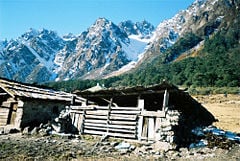
The lofty Himalayan ranges surround the northern, eastern and western borders of Sikkim in a crescent. The populated areas lie in the southern reaches of the state, in the Lower Himalayas. The state has twenty-eight mountain peaks, twenty-one glaciers, 227 high-altitude lakes, including the Tsongmo Lake, Gurudongmar and Khecheopalri Lakes, five hot springs, and over 100 rivers and streams. Eight mountain passes connect the state to Tibet, Bhutan and Nepal.[2]
Geology
The hills of Sikkim mainly consist of gneissose and half-schistose rocks, making their soil brown clay, and generally poor and shallow. The soil is coarse, with large amounts of iron oxide concentrations, ranging from neutral to acidic and has poor organic and mineral nutrients. This type of soil tends to support evergreen and deciduous forests.
A large portion of the Sikkim territory is covered by the Precambrian rock and is much younger in age than the hills. The rock consists of phyllites and schists and therefore the slopes are highly susceptible to weathering and prone to erosion. This, combined with the intense rain, causes extensive soil erosion and heavy loss of soil nutrients through leaching. As a result, landslides are frequent, isolating the numerous small towns and villages from the major urban centres.[2]
Hot Springs
Sikkim has many hot springs known for medicinal and therapeutic values. The most important hot springs are at Phurchachu(Reshi), Yumthang, Borang, Ralang, Taram-chu and Yumey Samdong. All these hot springs have high sulphur content and are located near river banks. The average temperature of the water in these hot springs is 50°C.
Climate
The climate ranges from sub-tropical in the south to tundra in the northern parts. Most of the inhabited regions of Sikkim, however, enjoy a temperate climate, with the temperatures seldom exceeding 28 °C (82 °F) in summer or dropping below 0 °C (32 °F) in winter. The state enjoys five seasons: winter, summer, spring, and autumn, and a monsoon season between June and September. The average annual temperature for most of Sikkim is around 18 °C (64 °F). Sikkim is one of the few states in India to receive regular snowfall. The snow line is around 6 000 metres (19,600 feet).
During the monsoon months, the state is lashed by heavy rains that increase the number of landslides. The state record for the longest period of non-stop rain is eleven days. In the northern region, because of high altitude, temperatures drop below −40 °C in winter. Fog also affects many parts of the state during winter and the monsoons, making transportation extremely perilous.[2]
Subdivisions
Sikkim has four districts, each overseen by a Central Government appointee, the district collector, who is in charge of the administration of the civilian areas of the districts. The Indian army has control of a large territory, as the state is a sensitive border area. Many areas are restricted and permits are needed to visit them. There are a total of eight towns and nine subdivisions in Sikkim.
The four districts are East Sikkim, West Sikkim, North Sikkim and South Sikkim. The district capitals are Gangtok, Geyzing, Mangan and Namchi respectively.[3] These Four Districts are further divided into Subdivisions. "Pakyong" is the subdivision of East District. "Soreng" is the subdivision of West District. "Chungthang" is the subdivision of North District. "Ravongla" is the subdivision of South District.[10]
Flora and fauna
Sikkim is situated in an ecological hotspot of the lower Himalayas, one of only three among the Ecoregions of India. The forested regions of the state exhibit a diverse range of fauna and flora. Owing to its altitudinal gradation, the state has a wide variety of plants, from tropical to temperate to alpine and tundra, and is perhaps one of the few regions to exhibit such a diversity within such a small area.
The flora of Sikkim includes the rhododendron, the state tree, with a huge range of species occurring from subtropical to alpine regions. Orchids, figs, laurel, bananas, sal trees and bamboo in the lower altitudes of Sikkim, which enjoy a subtropical-type climate. In the temperate elevations above 1,500 metres, oaks, chestnuts, maples, birches, alders, and magnolias grow in large numbers. The alpine-type vegetation includes juniper, pine, firs, cypresses and rhododendrons, and is typically found between an altitude of 3,500 to 5 000 m. Sikkim boasts around 5,000 flowering plants, 515 rare orchids, 60 primula species, 36 rhododendron species, 11 oak varieties, 23 bamboo varieties, 16 conifer species, 362 types of ferns and ferns allies, 8 tree ferns, and over 424 medicinal plants. The orchid Dendrobium nobile is the official flower of Sikkim.
The fauna includes the snow leopard, the musk deer, the Bhoral, the Himalayan Tahr, the red panda, the Himalayan marmot, the serow, the goral, the barking deer, the common langur, the Himalayan Black Bear, the clouded leopard, the Marbled Cat, the leopard cat, the wild dog, the Tibetan wolf, the hog badger, the binturong, the jungle cat and the civet cat. Among the animals more commonly found in the alpine zone are yaks, mainly reared for their milk, meat, and as a beast of burden.
The avifauna of Sikkim is comprised of the Impeyan pheasant, the crimson horned pheasant, the snow partridge, the snow cock, the lammergeyer and griffon vultures, as well as golden eagles, quail, plovers, woodcock, sandpipers, pigeons, Old World flycatchers, babblers and robins. A total of 550 species of birds have been recorded in Sikkim, some of which have been declared endangered.[2]
Sikkim also has a rich diversity of arthropods, much of which remains unexplored even today. The best studied group remains, as with the rest of India, the butterflies. Of the approximately 1438[11] butterfly species found in the Indian subcontinent, 695 have been recorded from Sikkim. These include the endangered Kaiser-i-hind, Yellow Gorgon and the Bhutan Glory amongst others.[12].
Economy
Macro-economic trend
This is a chart of trend of gross state domestic product of Sikkim at market prices estimated by the Ministry of Statistics and Programme Implementation with figures in millions of Indian Rupees.[13]
| Year | Gross State Domestic Product |
|---|---|
| 1980 | 520 |
| 1985 | 1,220 |
| 1990 | 2,340 |
| 1995 | 5,200 |
| 2000 | 9,710 |
| 2003 | 23,786 [1] |
Sikkim's gross state domestic product for 2004 is estimated at $478 million in current prices.
Sikkim's economy is largely agrarian, based on traditional farming methods, on terraced slopes. The rural populace grows crops such as cardamom, ginger, oranges, apples, tea and orchids.[3] Rice is grown on terraced hillsides in the southern reaches. Sikkim has the highest production and largest cultivated area of cardamom in India. Because of the hilly terrain, and lack of reliable transportation infrastructure, there are no large-scale industries. Breweries, distilleries, tanning and watchmaking are the main industries. These are located in the southern reaches of the state, primarily in the towns of Melli and Jorethang. The state has an impressive growth rate of 8.3%, which is the second highest in the country after Delhi.[14]
In recent years, the government of Sikkim has promoted tourism. Sikkim has a vast tourism potential and by tapping into this the state has grossed an earnings windfall. With the general improvement in infrastructure, tourism is slated to be the mainstay of Sikkim's economy. A fledgling industry the state has recently invested in is online gambling. The "Playwin" lottery, which is played on custom-built terminals connected to the Internet, has been a commercial success, with operations all over the country.[15] Among the minerals mined in Sikkim are copper, dolomite, limestone, graphite, mica, iron and coal.[16]
The opening of the Nathula Pass on July 6 2006 connecting Lhasa, Tibet to India is expected to give a boost to the local economy, though the financial benefits will be slow to arrive. The Pass, closed since the 1962 Sino-Indian War, was an offshoot of the ancient Silk Road, which was essential to the wool, fur and spice trade.[9]
Transport
Sikkim does not have any airports or railheads because of its rough terrain. The closest airport, Bagdogra Airport, is near the town of Siliguri, West Bengal. The airport is about 124 km away from Gangtok. A regular helicopter service run by the Sikkim Helicopter Service connects Gangtok to Bagdogra; the flight is thirty minutes long, operates only once a day, and can carry 4 people.[17] The Gangtok helipad is the only civilian helipad in the state. The closest railway station is New Jalpaiguri which is situated sixteen kilometres from Siliguri.[3]
National Highway 31A links Siliguri to Gangtok. The highway is an all-weather metalled road which mostly runs parallel to the river Teesta, entering Sikkim at Rangpo. Numerous public and privately run bus and jeep services connect the airport, railway station, and Siliguri to Gangtok. A branch of the highway from Melli connects western Sikkim. Towns in southern and western Sikkim are connected to the northern West Bengal hill stations of Kalimpong and Darjeeling. Within the state, four wheel drives are the most popular means of transport, as they can navigate rocky slopes. Minibuses link the smaller towns to the state and district headquarters.[3]
Demographics
Today the majority of Sikkim's residents are of Nepali ethnic-national origin who came to the province in the 19th century. The native Sikkimese consist of the Bhutias, who migrated from the Kham district of Tibet in the 14th century, and the Lepchas who are believed to have migrated from the Far East. Tibetans reside mostly in the northern and eastern reaches of the state. Immigrant resident communities not native to the state include the Marwaris, who own most of the shops in South Sikkim and Gangtok; the Biharis, most of whom are employed in blue collar jobs; and the Bengalis.
Hinduism is the majority religion in the state with 60.9% of the population adhering to the religion [18]. Buddhism forms a large minority with 28.1% of the population following the religion [19]. Christian's form 6.7% of the population [20], consisting mostly of people of Lepcha origin, converted to the faith after British missionaries started preaching in the region in the late 19th century. The state has never had inter-religious strife. Mosques in downtown Gangtok and Mangan also serve the Muslim population, which numbers at 1.4% of the population [21].
Nepali is the lingua franca of Sikkim. English and Hindi are also spoken and understood in most of Sikkim. Other languages spoken in Sikkim include Bhutia, Dzongkha, Groma, Gurung, Lepcha, Limbu, Magar, Majhi, Majhwar, Nepal Bhasa, Rai, Sherpa, Sunuwar, Tamang, Thulung, Tibetan, and Yakha.[3][22]
As India's least populous state, Sikkim has only 540,493 inhabitants,[23] with 288,217 males and 252,276 females. It is also one of the least densely populated states with only 76 persons per square kilometre. Its growth rate is 32.98% (1991–2001). The sex ratio is 875 females per 1000 males. With 50,000 inhabitants, Gangtok is the state's only significant town. The urban population in Sikkim is 11.06%.[10] The per capita income stands at Rs. 11,356, which is one of the highest in the country.[22]
Culture
Sikkim residents celebrate all major Indian festivals such as Diwali and Dussera, the popular Hindu festivals. Losar, Loosong, Saga Dawa, Lhabab Duechen, Drupka Teshi and Bhumchu are Buddhist festivals that are also celebrated. During the Losar – the Tibetan New Year in mid-December – most government offices and tourist centres are closed for a week. Christmas has also recently been promoted in Gangtok to attract tourists during the off-season.[24]
It is common to hear Western rock music being played in homes and in restaurants even in the countryside. Hindi songs have gained wide acceptance among the masses. Indigenous Nepali rock, music suffused with a Western rock beat and Nepali lyrics, is also particularly popular. Football and cricket are the two most popular sports.
Noodle-based dishes such as the thukpa, chowmein, thanthuk, fakthu, gyathuk and wonton are common in Sikkim. Momos, steamed dumplings filled with vegetable, buff (buffalo's meat) or pork and served with a soup are a popular snack. The mountain peoples have a diet rich in beef, pork and other meats. Alcohol is cheap owing to the low excise duty in Sikkim and beer, whiskey, rum and brandy are consumed by many Sikkimese.
Almost all dwellings in Sikkim are rustic, consisting of a bamboo frame, woven with pliable bamboo and coated with cow dung, providing a warm interior. In the higher elevations, houses are made of wood.
Government and politics
Like all states of India, the head of the state government is a governor appointed by the Central Indian Government. His appointment is largely ceremonial, and his main role is to oversee the swearing in of the Chief Minister. The Chief Minister, who holds the real executive powers, is the head of the party or coalition garnering the largest majority in the state elections. The governor also appoints the cabinet ministers on the advice of the Chief Minister. Sikkim has a unicameral legislature like most other Indian states. Sikkim is allocated one seat in each of both chambers of India's national bicameral legislature, the Lok Sabha, and the Rajya Sabha. There are a total of 32 state assembly seats including one reserved for the Sangha. The Sikkim High Court is the smallest high court in the country.[25]
| State animal | Red Panda |
| State bird | Blood Pheasant |
| State tree | Rhododendron |
| State flower | Noble orchid |
In 1975, after the abrogation of Sikkim's monarchy, the Congress Party got the largest majority in the 1977 elections. In 1979, after a period of instability, a popular ministry headed by Nar Bahadur Bhandari, leader of the Sikkim Sangram Parishad Party was sworn in. Bhandari held on to power in the 1984 and 1989 elections. In the 1994 elections Pawan Kumar Chamling from the Sikkim Democratic Front becoming the Chief Minister of the state. The party has since held on to power by winning the 1999 and 2004 elections.[6][17]
- See also: Elections in Sikkim and List of political parties in the state
Infrastructure
Although roads in Sikkim are often exposed to landslides and flooding by nearby streams, the roads are significantly better than the equivalent roads of other Indian states. The roads are maintained by the Border Roads Organisation (BRO), an offshoot of the Indian army. The roads in South Sikkim and NH-31A are in good condition, landslides being less frequent in these areas. The state government maintains 1857.35 km of roadways that do not fall in the BRO jurisdiction.[10]
Sikkim has a number of hydroelectric power stations, providing a steady electricity source. However the voltage is unstable and voltage stabilisers are needed. Per capita consumption of electricity in Sikkim is 182 kWh. 73.2% of households have access to safe drinking water,[10] and the large number of streams assures abundant water supply, thus the state never witnesses droughts. A number of hydel projects are under construction on the Teesta river and their likely environmental impact is a matter of concern.
Media
The southern urban areas have English, Nepali and Hindi dailies. Nepali language newspapers are locally printed, whereas Hindi and English newspapers are printed in Siliguri. English newspapers include The Statesman and The Telegraph which are printed in Siliguri, as well as The Hindu and The Times of India, printed in Calcutta, and are received with a day's delay in the towns of Gangtok, Jorethang, Melli and Geyzing. The Sikkim Herald is an official weekly publication of the government. The Haalkhabar is the only International standard daily news portal from Sikkim.
Internet cafés are well established in the district capitals, but broadband connectivity is not widely available, and many rural areas have yet to be linked to the Internet. Satellite television channels through dish antennae are available in most homes in the state. Channels served are the same available throughout India along with a Nepali language channels. The main service providers are Sikkim Cable, Dish TV, Doordarshan and Nayuma. The area is well serviced by local cellular companies such as BSNL, Reliance Infocomm, and Airtel. BSNL has state wide coverage, whereas Reliance Infocomm and Airtel have coverage only in urban areas. The national All India Radio is the only radio station in the state.[26]
Education
Literacy is 69.68%, which breaks down into 76.73% for males and 61.46% for females. There are a total of 1545 government-run educational institutions and eighteen private schools mostly located in the towns.[10] There are about twelve colleges and other institutions in Sikkim that offer higher education. The largest institution is the Sikkim Manipal University of Health Medical and Technological Sciences which offers higher education in engineering, medicine and management. It also runs a host of distance education in diverse fields. There are two state-run polytechnics, Advanced Technical Training Centre (ATTC) and Centre for Computers and Communication Technology (CCCT) in Sikkim which offer diploma courses in various branches of engineering. ATTC is situated at Bardang, Singtam and CCCT at Chisopani, Namchi. Many students however, migrate to Siliguri and Calcutta for their higher education.
Notes
- ↑ Arjun Adlakha (April 1997). Population Trends: India (PDF). International brief pp. 5. U.S. Department of Commerce. Retrieved 2006-10-12.
- ↑ 2.0 2.1 2.2 2.3 2.4 2.5 Physical Features of Sikkim. Department of Information and Public Relations, Government of Sikkim (2005-09-29). Retrieved 2006-10-12.
- ↑ 3.0 3.1 3.2 3.3 3.4 3.5 3.6 General Information. Sikkiminfo.net. Retrieved 2006-10-12.
- ↑ About Sikkim. Department of Information and Public Relations, Government of Sikkim (2005-09-29). Retrieved 2006-10-12.
- ↑ 5.0 5.1 History of Sikkim. Department of Information and Public Relations, Government of Sikkim (2005-09-29). Retrieved 2006-10-12.
- ↑ 6.0 6.1 History of Sikkim. Government of Sikkim (2002-08-29). Retrieved 2006-10-12.
- ↑ Elections after the merger. Sikkiminfo.net. Retrieved 2006-10-12.
- ↑ Baruah, Amit, "China backs India's bid for U.N. Council seat", The Hindu, 2005-04-12. Retrieved 2006-10-12.
- ↑ 9.0 9.1 "Hisotric India-China link opens", BBC, 2006-07-06. Retrieved 2006-10-12.
- ↑ 10.0 10.1 10.2 10.3 10.4 Sikkim at a glance. Department of Information and Public Relations, Government of Sikkim (2005-09-29). Retrieved 2006-10-12.
- ↑ Evans,W.H.(1932) The Identification of Indian Butterflies, (2/e) pp 23
- ↑ Haribal, Meena (1994) Butterflies of Sikkim, pg 9.
- ↑ National Accounts Division : Press release & Statements. Ministry of Statistics and Programme Implementation (2006-05-23). Retrieved 2006-10-12.
- ↑ Economy of Sikkim. Department of Information and Public Relations, Government of Sikkim (2005-09-29). Retrieved 2006-10-12.
- ↑ Playwin lottery. Interplay Multimedia Pty. Ltd. (2006-08-20). Retrieved 2006-10-12.
- ↑ Sikkim's Economy. National Informatics Centre (2002-08-29). Retrieved 2006-10-12.
- ↑ 17.0 17.1 30 Years of Statehood In a Nutshell. Department of Information and Public Relations, Government of Sikkim (2005-11-24). Retrieved 2006-10-12.
- ↑ http://www.censusindia.net/religiondata/ 2001 Indian Census Data
- ↑ http://www.censusindia.net/religiondata/ 2001 Indian Census Data
- ↑ http://www.censusindia.net/religiondata/ 2001 Indian Census Data
- ↑ http://www.censusindia.net/religiondata/ 2001 Indian Census Data
- ↑ 22.0 22.1 People of Sikkim. Department of Information and Public Relations, Government of Sikkim (2005-09-29). Retrieved 2006-10-12.
- ↑ Sikkim statistics. Government of India. Retrieved 2006-10-12.
- ↑ Culture and Festivals of Sikkim. Department of Information and Public Relations, Government of Sikkim (2005-09-29). Retrieved 2006-10-12.
- ↑ "Judge strengths in High Courts increased", Ministry of Law & Justice, 2003-10-30. Retrieved 2006-10-12.
- ↑ Entertainment in Sikkim. Sikkiminfo.net. Retrieved 2006-10-12.
ReferencesISBN links support NWE through referral fees
- Evans, W.H. (1932) The Identification of Indian Butterflies. (2nd Ed), Bombay Natural History Society, Mumbai, India.
- Haribal, Meena (1992) Butterflies of Sikkim Himalaya and their Natural History. Sikkim Nature Conservation Foundation.
- Hooker, Joseph Dalton "Himalayan Journals" Ward, Lock, Bowden & Co. Assistant-director of the Royal Botanic Gardens, Kew.
- Holidaying in Sikkim and Bhutan – published by Nest and Wings – ISBN 81-87592-07-9
- Sikkim — Land of Mystic and Splendour – published by Sikkim Tourism.
- Manorama Yearbook 2003 – ISBN 81-900461-8-7
External links
- Official website of the Government of Sikkim, Maintained by Department of Information Technology
- Details of the census
- Ecosystem of Sikkim — Flora, Fauna, Mountain passes, climate mentioned here.
- History of Sikkim
- Sinlung News
- Sikkim state statistics Figures on Sikkim's population, per capita income, density etc.
- China backs India's bid for U.N. Council seat; Amit Baruah; The Hindu 2005-04-12.
- Historic India-China link opens, BBC News.
- {{{2}}} at the Open Directory Project
- Travel guide to Sikkim from Wikitravel
| ||||||||||
Credits
New World Encyclopedia writers and editors rewrote and completed the Wikipedia article in accordance with New World Encyclopedia standards. This article abides by terms of the Creative Commons CC-by-sa 3.0 License (CC-by-sa), which may be used and disseminated with proper attribution. Credit is due under the terms of this license that can reference both the New World Encyclopedia contributors and the selfless volunteer contributors of the Wikimedia Foundation. To cite this article click here for a list of acceptable citing formats.The history of earlier contributions by wikipedians is accessible to researchers here:
The history of this article since it was imported to New World Encyclopedia:
Note: Some restrictions may apply to use of individual images which are separately licensed.
